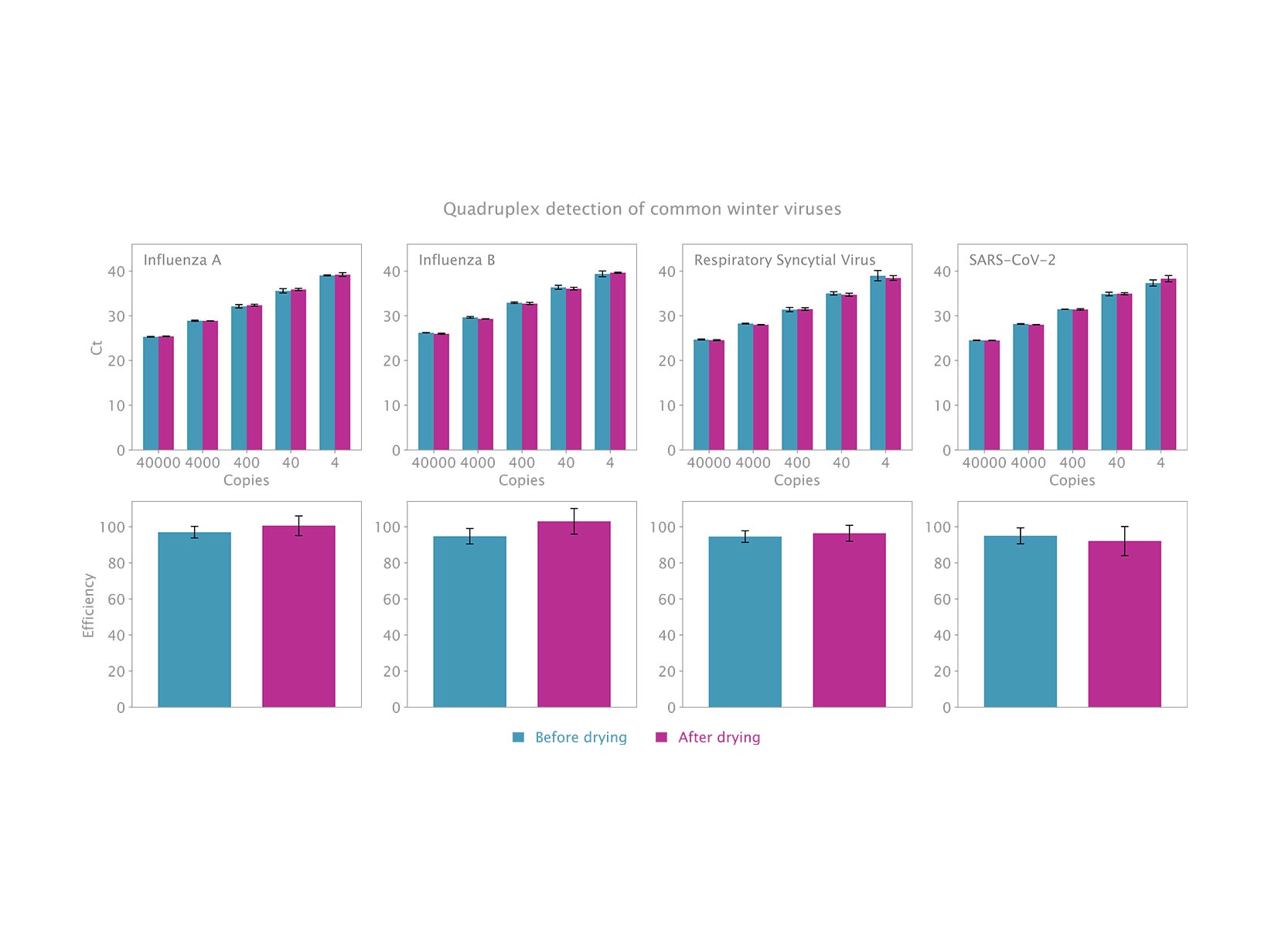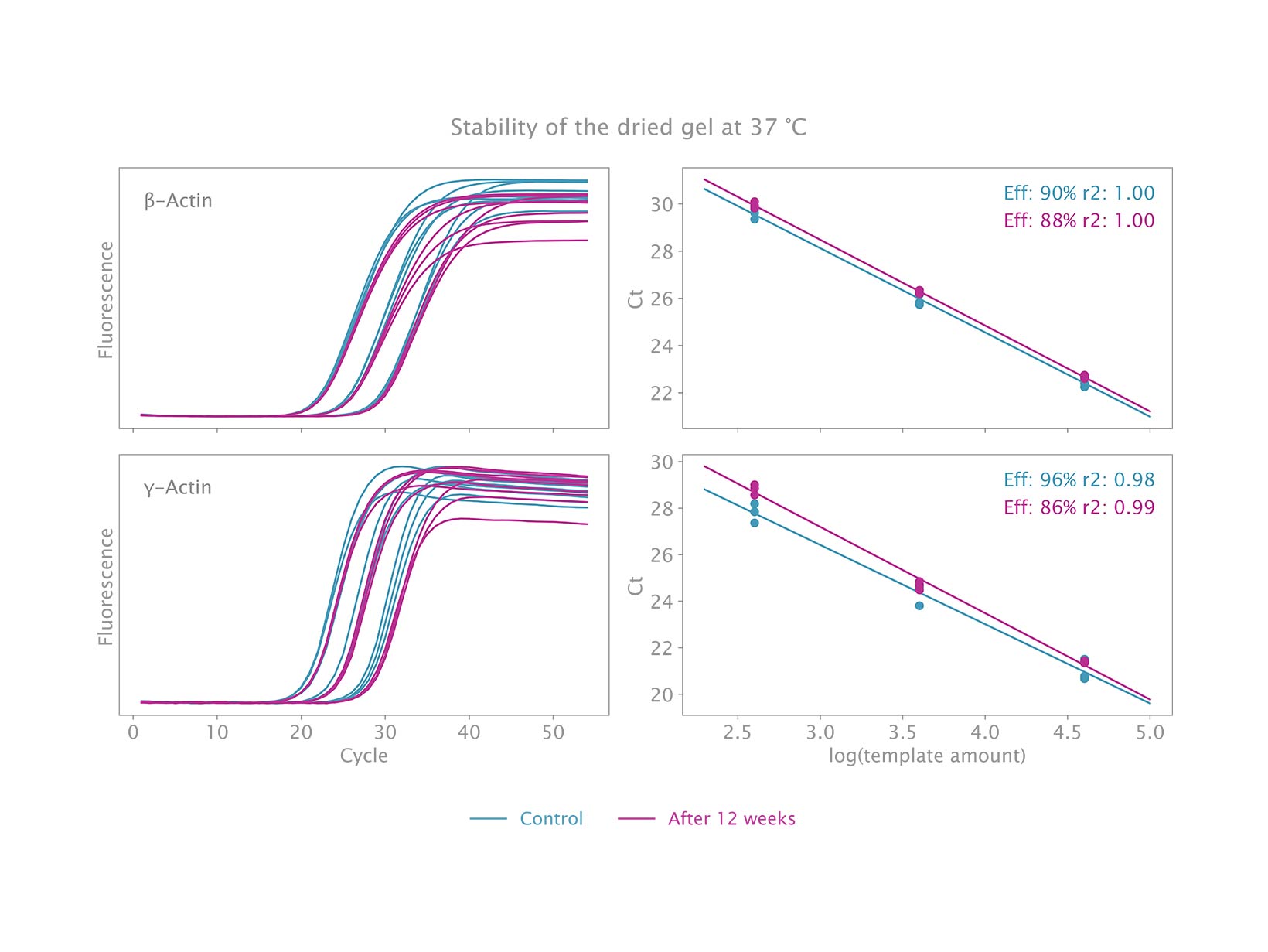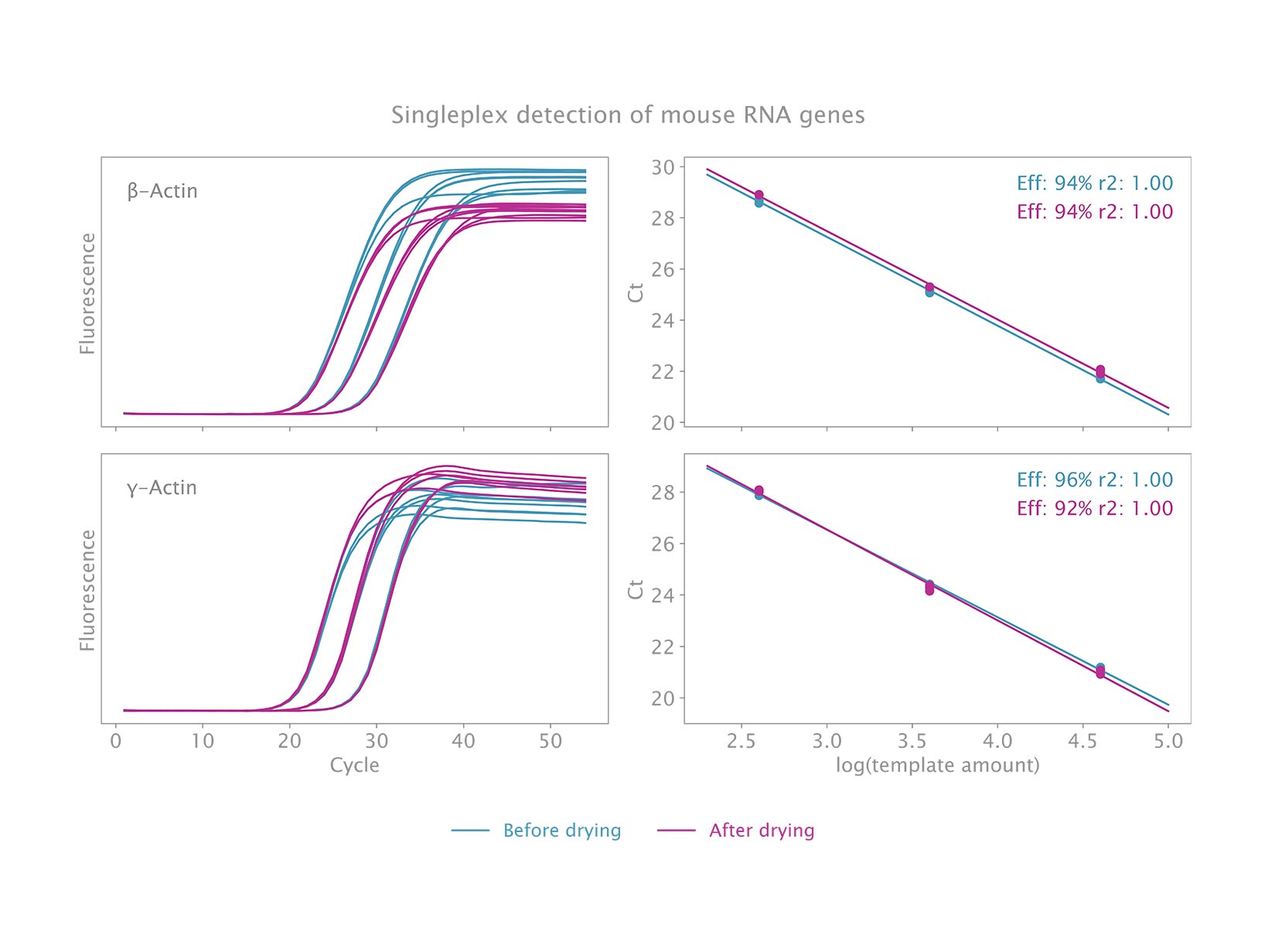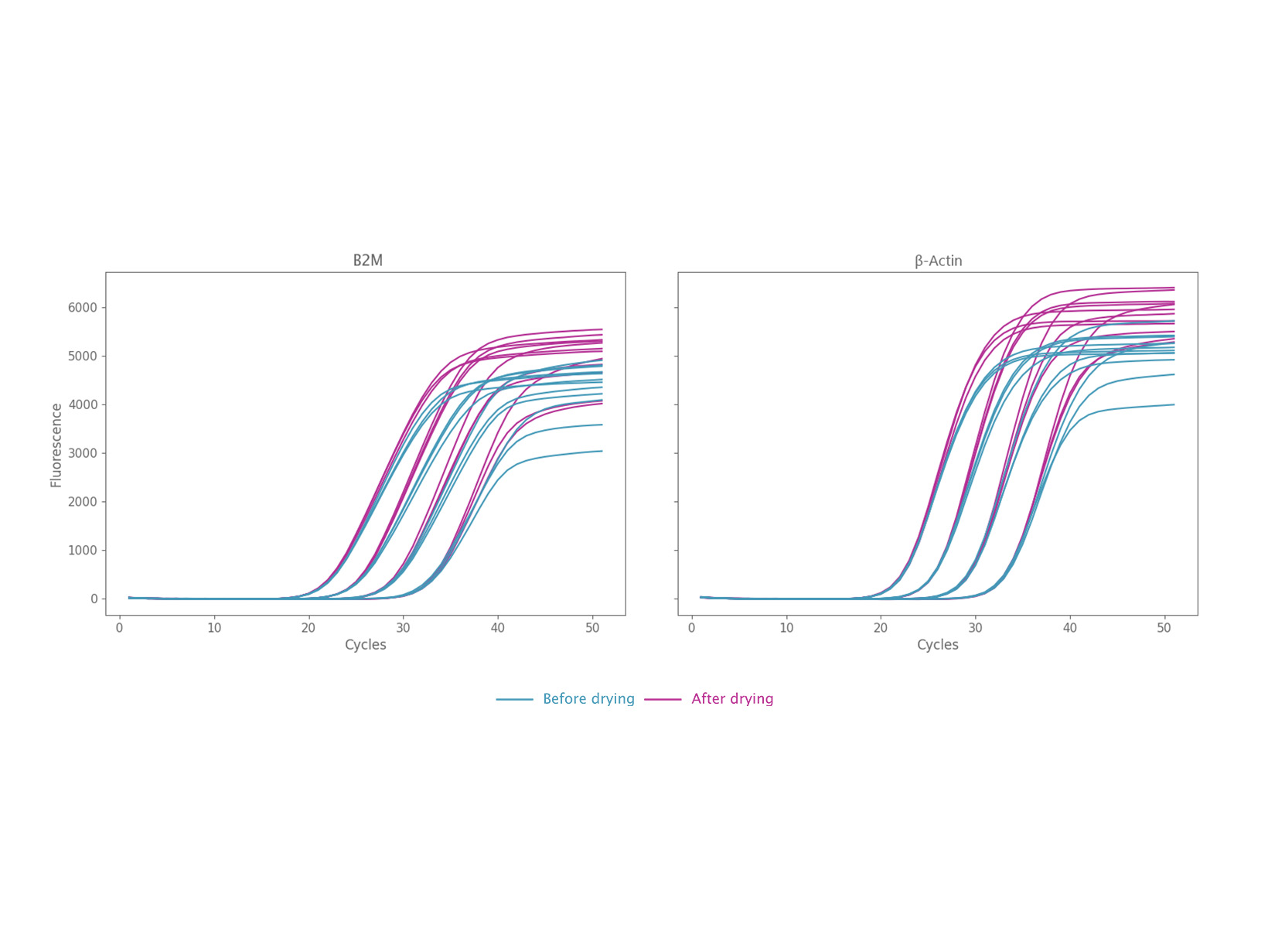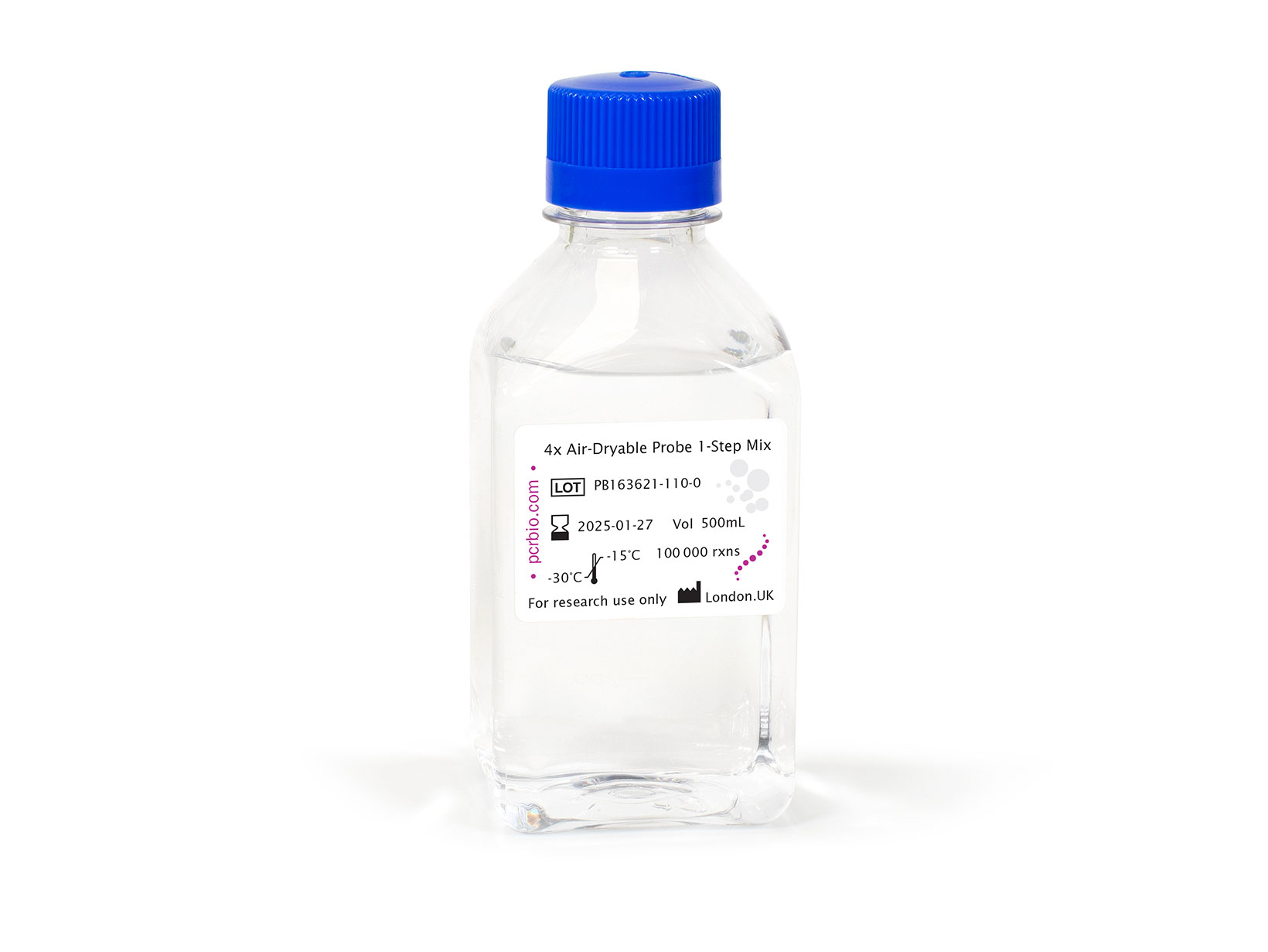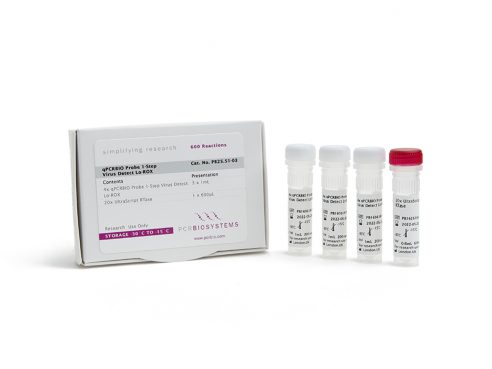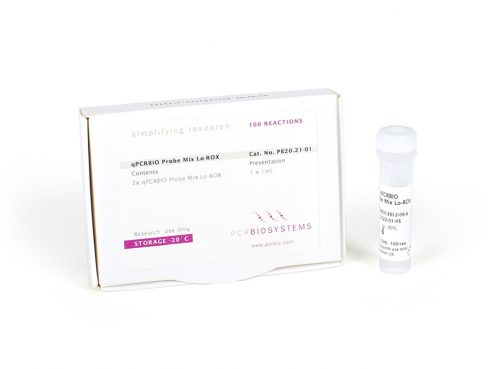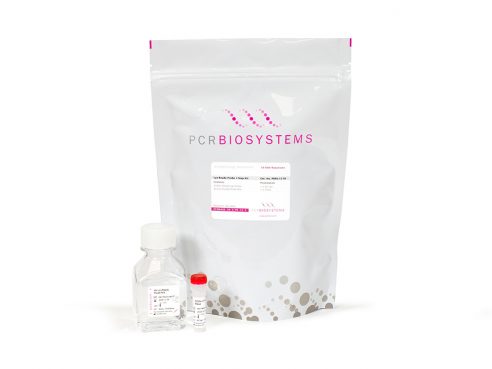To view your price please login or contact us
Air-Dryable Probe Mix and Probe 1-Step Mix
Air-Dryable Probe Mix and Probe 1-Step Mix are versatile all-in-one, air-dryable 4x qPCR and RT-qPCR reagent mixes for ultra-sensitive detection of RNA and DNA sequences.
Designed for rapid air-drying, these qPCR and RT-qPCR mixes enable dried assay formats using a standard laboratory oven, offering a simpler, faster, and cheaper alternative to lyophilisation. An optimal blend of excipients ensures reliable air-drying, without loss of activity. Choose Air-Dryable Probe Mix when working with DNA only, or use Air-Dryable Probe 1-Step Mix for efficient detection of both DNA and RNA targets.
Features
- Unbiased, sensitive detection of both DNA and RNA targets, 4 copies per reaction
- Complete 1-step RT-qPCR mix, single tube format
- Easy reaction set up, add only primers & probes before drying
- Rapid air-drying protocol, 80-90 min drying time
- Same high performance before & after drying
- Room temperature storage and shipping of dried reactions
- Increased sample volume input
More Information
The Air-Dryable Probe 1-Step Mix includes a glycerol-free 4x qPCR mix containing hot start Taq polymerase, dNTPs, MgCl2 and a blend of excipients to ensure reliable air-drying, without loss of activity. The mastermix also contains a novel version of UltraScript Reverse Transcriptase, modified to increase stability upon drying, and our RiboShield™ RNase inhibitor, so the final blend is suitable both for qPCR detection of DNA and 1-Step RT-qPCR for detection of RNA targets.
Designed for rapid air-drying, Air-Dryable Probe 1-Step Mix is intended for use in in-vitro diagnostic kit development (IVD) but can also be used for anyone wishing to benefit from the advantages of dried (RT-)qPCR reactions. Air-drying protocols require significantly less time and expertise than freeze drying (lyophilisation) and very simple equipment. 5 μL of 4x Air-Dryable Probe 1-Step Mix (required for a 20 μL final reaction volume) can be dried down into a gel using a standard laboratory oven in as little as 80-90 min.
Air-Dryable Probe 1-Step Mix is presented in a single tube format in order to make assay setup for 1-step probe-based RT-qPCR detection of RNA or DNA as simple as possible. The mix is specially formulated for air-drying of the reaction mix, requiring only the addition of primers and probes prior to drying. Reconstitution of the mix is equally simple, necessitating addition only of sample and, optionally, water to make up the final reaction volume. A quick vortexing of the plate will guarantee full reconstitution of the gel.
Key benefits of air-drying
- Reduced volume and mass of reaction mixes leads to cheaper shipping and storage.
- Room temperature stability of the air-dried final gel eliminates the need for cold-chain shipping and storage. This simplifies logistics and reduces overall cost.
- Increased volumes of sample can be used. The sample input volume can equal the final reaction volume. This is perfect for dilute samples (with a low target copy number).
- Air-drying in an oven is a highly accessible method, because there is no requirement for specialist equipment and knowledge, eliminating the need for additional staff or project out-sourcing
- Increased control over the drying process and final product development for small and medium sized IVD kit developers
Applications
- Diagnostic probe-based qPCR & RT-qPCR
- DNA & RNA detection
- TaqMan®, Scorpions® and molecular beacon probe qPCR
- Multiplex and singleplex qPCR setup
Specifications
Air-Dryable Probe 1-Step Mix
Component
600 reactions
2000 reactions
10 000 reactions
100 000 reactions
4x Air-Dryable Probe 1-Step Mix
3 x 1 mL
2 x 5 mL
1 x 50 mL
1 x 500 mL
Air-Dryable Probe Mix
Component
600 reactions
2000 reactions
10 000 reactions
4x Air-Dryable Probe Mix
3 x 1 mL
2 x 5 mL
1 x 50 mL
Air-Dryable Probe 1-Step Mix
Component
4x Air-Dryable Probe 1-Step Mix
600 reactions
3 x 1 mL
2000 reactions
2 x 5 mL
10 000 reactions
1 x 50 mL
100 000 reactions
1 x 500 mL
Air-Dryable Probe Mix
Component
4x Air-Dryable Probe Mix
600 reactions
3 x 1 mL
2000 reactions
2 x 5 mL
10 000 reactions
1 x 50 mL
Reaction Volume
Storage
20 μL
On arrival, products should be stored between -30 °C and -15 °C. If stored correctly the kit will retain full activity until the indicated expiry date.
Reaction Volume
20 μL
Storage
On arrival, products should be stored between -30 °C and -15 °C. If stored correctly the kit will retain full activity until the indicated expiry date.
Documents
Product Flyers
Material Safety Data Sheets
Certificate of Analysis Finder
FAQs
Can I alter the drying conditions?
The drying conditions provided in the product manual are only an example of the tested cycles used in our labs. When air-drying, it is important to get a loss of weight (Loss on Drying, LoD), of approximately 70-75 %, which results in a dried gel containing only 5-10 % water.
Drying times may vary depending on the instrument used. When using this product for the first time with a specific oven, we recommend measuring the LoD using multiple tubes at regular times (e.g., after 60, 70, 80, 90 min) to define the best protocol and achieve a LoD of 74.5 ± 10.5 % or 70 ± 1 % based on the mix (with or without oligos) and the drying instrument used.
Temperatures can also be changed, but obviously lower temperatures will require longer times, while higher temperatures risk affecting the integrity of the mix components, so we recommend using 40 °C to minimise the chances of unexpected problems.
Can I lyophilise this mix?
Although we successfully managed to lyophilise this mix, we do not recommend it be lyophilised. The excipient content has been optimised for air drying and this significantly reduces stability of the product lyophilisation. We recommend using this mix for air-drying only and recommend our Lyo-Ready product range for lyophilisation protocols.
Can I use this Probe 1-Step mix to detect DNA?
Absolutely. This is our first universal All-in-One mix, meaning that it already contains the RTase. Critically, this does not affect the performance of our HS Taq polymerase, hence it can be used both with RNA or with DNA as template. We do not recommend simultaneous detection of RNA and DNA targets in a single multiplex reaction.
How can I resuspend the dried gel?
If 5 – 6 μL of mix (plus oligos) were dried in each well, it is sufficient to resuspend the gel with 20 μL of template in water. After resuspension, we recommend vortexing the sealed plate for about 1 min to achieve a homogeneous solution in each well.
How do I store my dried reaction mixes?
Once dried, seal tubes/plates. In this way, they can be stored at room temperature for at least 1.5 year. For long-term storage, we recommend storing the plates inside zip lock bags with silica gel bags.
How does the product compare to standard liquid format qPCR mixes?
The dried mix behaves similarly to the wet mix, with no significant reduction of fluorescence or delay in amplification. It also shows the same sensitivity and efficiency as all our Probe 1-Step mixes, detecting down to 4 copies of viral genome.
How long is the dried gel stable for?
We observed no significant loss of activity (i.e., no reduction of the fluorescence plateau and less than 1 Ct delay in amplification) when we incubated the dried gels at 37 °C for 3 months.
How many targets can I detect at once (multiplex reactions)?
We successfully amplify 2 different sets of 4 targets simultaneously. External users report successfully running more complex multiplex reactions. Please share any feedback and results on this with us at [email protected].
How should I store the mix before drying?
On arrival the kit should be stored between -30 °C and -15 °C. If stored correctly the kit will retain full activity for 12 months
My reaction mix won’t dry down, what should I do?
Please check that the instrument used to dry the mix is correctly set up, connected to a power source, and operating correctly.
Also be sure not to exceed a maximum of 5 – 6 μL of mix (including oligos and ROX dye) per well when drying down. Please ensure you are following the instructions provided in the manual. Optimal drying times may differ among different ovens. We recommend optimising the drying conditions for your reaction as necessary, starting with the indications provided in our manual.
What is the maximum volume I can dry down?
We recommend using the smallest volume possible to minimize the time for the procedure. This means drying 5 μL of the 4x mix alone (for a 20 μL reaction). If primers, probes, and eventually ROX (if the PCR instrument requires it) are added before the process, stock solutions at high concentrations should be prepared, in order to add the smallest volume possible to the 4x mix. We recommend not exceeding 1 extra μL. Larger volumes would require longer drying times and higher LoD to reach the same percentage of remaining water in the dried product. When drying 6 μL of the mix with primers and probes, the LOD needs to be 74.5 % ± 0.5 %, and for that we recommend drying the mix at 40 °C for 80-90 min.
What should I do if I want to dry down larger volumes?
We do not recommend drying more than 5 – 6 μL of mix (plus oligos) per well following the instructions provided into the manual. Multiple plates can be dried at the same time for high throughput of manufacturing. We do not recommend air-drying larger volumes and recommend lyophilisation, using our Lyo-Ready range of products.
More Information
The Air-Dryable Probe 1-Step Mix includes a glycerol-free 4x qPCR mix containing hot start Taq polymerase, dNTPs, MgCl2 and a blend of excipients to ensure reliable air-drying, without loss of activity. The mastermix also contains a novel version of UltraScript Reverse Transcriptase, modified to increase stability upon drying, and our RiboShield™ RNase inhibitor, so the final blend is suitable both for qPCR detection of DNA and 1-Step RT-qPCR for detection of RNA targets.
Designed for rapid air-drying, Air-Dryable Probe 1-Step Mix is intended for use in in-vitro diagnostic kit development (IVD) but can also be used for anyone wishing to benefit from the advantages of dried (RT-)qPCR reactions. Air-drying protocols require significantly less time and expertise than freeze drying (lyophilisation) and very simple equipment. 5 μL of 4x Air-Dryable Probe 1-Step Mix (required for a 20 μL final reaction volume) can be dried down into a gel using a standard laboratory oven in as little as 80-90 min.
Air-Dryable Probe 1-Step Mix is presented in a single tube format in order to make assay setup for 1-step probe-based RT-qPCR detection of RNA or DNA as simple as possible. The mix is specially formulated for air-drying of the reaction mix, requiring only the addition of primers and probes prior to drying. Reconstitution of the mix is equally simple, necessitating addition only of sample and, optionally, water to make up the final reaction volume. A quick vortexing of the plate will guarantee full reconstitution of the gel.
Key benefits of air-drying
- Reduced volume and mass of reaction mixes leads to cheaper shipping and storage.
- Room temperature stability of the air-dried final gel eliminates the need for cold-chain shipping and storage. This simplifies logistics and reduces overall cost.
- Increased volumes of sample can be used. The sample input volume can equal the final reaction volume. This is perfect for dilute samples (with a low target copy number).
- Air-drying in an oven is a highly accessible method, because there is no requirement for specialist equipment and knowledge, eliminating the need for additional staff or project out-sourcing
- Increased control over the drying process and final product development for small and medium sized IVD kit developers
Applications
- Diagnostic probe-based qPCR & RT-qPCR
- DNA & RNA detection
- TaqMan®, Scorpions® and molecular beacon probe qPCR
- Multiplex and singleplex qPCR setup
Specifications
Air-Dryable Probe 1-Step Mix
Component
600 reactions
2000 reactions
10 000 reactions
100 000 reactions
4x Air-Dryable Probe 1-Step Mix
3 x 1 mL
2 x 5 mL
1 x 50 mL
1 x 500 mL
Air-Dryable Probe Mix
Component
600 reactions
2000 reactions
10 000 reactions
4x Air-Dryable Probe Mix
3 x 1 mL
2 x 5 mL
1 x 50 mL
Air-Dryable Probe 1-Step Mix
Component
4x Air-Dryable Probe 1-Step Mix
600 reactions
3 x 1 mL
2000 reactions
2 x 5 mL
10 000 reactions
1 x 50 mL
100 000 reactions
1 x 500 mL
Air-Dryable Probe Mix
Component
4x Air-Dryable Probe Mix
600 reactions
3 x 1 mL
2000 reactions
2 x 5 mL
10 000 reactions
1 x 50 mL
Reaction Volume
Storage
20 μL
On arrival, products should be stored between -30 °C and -15 °C. If stored correctly the kit will retain full activity until the indicated expiry date.
Reaction Volume
20 μL
Storage
On arrival, products should be stored between -30 °C and -15 °C. If stored correctly the kit will retain full activity until the indicated expiry date.
Documents
Product Flyers
Material Safety Data Sheets
Certificate of Analysis Finder
FAQs
Can I alter the drying conditions?
The drying conditions provided in the product manual are only an example of the tested cycles used in our labs. When air-drying, it is important to get a loss of weight (Loss on Drying, LoD), of approximately 70-75 %, which results in a dried gel containing only 5-10 % water.
Drying times may vary depending on the instrument used. When using this product for the first time with a specific oven, we recommend measuring the LoD using multiple tubes at regular times (e.g., after 60, 70, 80, 90 min) to define the best protocol and achieve a LoD of 74.5 ± 10.5 % or 70 ± 1 % based on the mix (with or without oligos) and the drying instrument used.
Temperatures can also be changed, but obviously lower temperatures will require longer times, while higher temperatures risk affecting the integrity of the mix components, so we recommend using 40 °C to minimise the chances of unexpected problems.
Can I lyophilise this mix?
Although we successfully managed to lyophilise this mix, we do not recommend it be lyophilised. The excipient content has been optimised for air drying and this significantly reduces stability of the product lyophilisation. We recommend using this mix for air-drying only and recommend our Lyo-Ready product range for lyophilisation protocols.
Can I use this Probe 1-Step mix to detect DNA?
Absolutely. This is our first universal All-in-One mix, meaning that it already contains the RTase. Critically, this does not affect the performance of our HS Taq polymerase, hence it can be used both with RNA or with DNA as template. We do not recommend simultaneous detection of RNA and DNA targets in a single multiplex reaction.
How can I resuspend the dried gel?
If 5 – 6 μL of mix (plus oligos) were dried in each well, it is sufficient to resuspend the gel with 20 μL of template in water. After resuspension, we recommend vortexing the sealed plate for about 1 min to achieve a homogeneous solution in each well.
How do I store my dried reaction mixes?
Once dried, seal tubes/plates. In this way, they can be stored at room temperature for at least 1.5 year. For long-term storage, we recommend storing the plates inside zip lock bags with silica gel bags.
How does the product compare to standard liquid format qPCR mixes?
The dried mix behaves similarly to the wet mix, with no significant reduction of fluorescence or delay in amplification. It also shows the same sensitivity and efficiency as all our Probe 1-Step mixes, detecting down to 4 copies of viral genome.
How long is the dried gel stable for?
We observed no significant loss of activity (i.e., no reduction of the fluorescence plateau and less than 1 Ct delay in amplification) when we incubated the dried gels at 37 °C for 3 months.
How many targets can I detect at once (multiplex reactions)?
We successfully amplify 2 different sets of 4 targets simultaneously. External users report successfully running more complex multiplex reactions. Please share any feedback and results on this with us at [email protected].
How should I store the mix before drying?
On arrival the kit should be stored between -30 °C and -15 °C. If stored correctly the kit will retain full activity for 12 months
My reaction mix won’t dry down, what should I do?
Please check that the instrument used to dry the mix is correctly set up, connected to a power source, and operating correctly.
Also be sure not to exceed a maximum of 5 – 6 μL of mix (including oligos and ROX dye) per well when drying down. Please ensure you are following the instructions provided in the manual. Optimal drying times may differ among different ovens. We recommend optimising the drying conditions for your reaction as necessary, starting with the indications provided in our manual.
What is the maximum volume I can dry down?
We recommend using the smallest volume possible to minimize the time for the procedure. This means drying 5 μL of the 4x mix alone (for a 20 μL reaction). If primers, probes, and eventually ROX (if the PCR instrument requires it) are added before the process, stock solutions at high concentrations should be prepared, in order to add the smallest volume possible to the 4x mix. We recommend not exceeding 1 extra μL. Larger volumes would require longer drying times and higher LoD to reach the same percentage of remaining water in the dried product. When drying 6 μL of the mix with primers and probes, the LOD needs to be 74.5 % ± 0.5 %, and for that we recommend drying the mix at 40 °C for 80-90 min.
What should I do if I want to dry down larger volumes?
We do not recommend drying more than 5 – 6 μL of mix (plus oligos) per well following the instructions provided into the manual. Multiple plates can be dried at the same time for high throughput of manufacturing. We do not recommend air-drying larger volumes and recommend lyophilisation, using our Lyo-Ready range of products.





